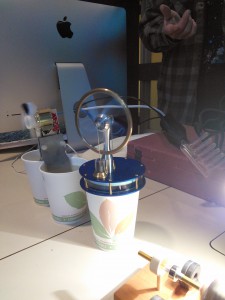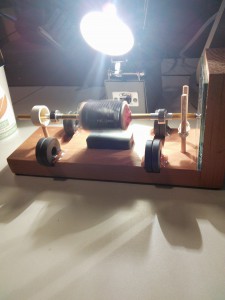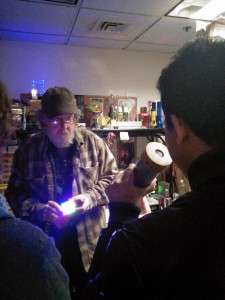“Any knowledge that doesn’t lead to new questions quickly dies out: it fails to maintain the temperature required for sustaining life.”
Tom Vales a Laboratory Coordinator at Suffolk University came into our class to demonstrate temperature and heat using a Tesla Coil and other devices. The first device he showed the class was a Stirling Engine. It was invented in 1816 by Robert Stirling as a heat engine, operating by cycle density and expansion of air. The engine is noted for its  high efficiency compared to the steam engine, quiet operation, and the effortlessness in which almost any heat source can be used. The gases within a Stirling Engine never leave so there is no exhaust valves that release high pressure gases and no explosions like the steam engine. Tom’s Stirling Engine runs on hot water and is used for pumping water.
high efficiency compared to the steam engine, quiet operation, and the effortlessness in which almost any heat source can be used. The gases within a Stirling Engine never leave so there is no exhaust valves that release high pressure gases and no explosions like the steam engine. Tom’s Stirling Engine runs on hot water and is used for pumping water.
The class was then shown a Peltier Engine is based off of Jean Charles Athanase Peltier’s effect. It was discovered in 1834, when a current is made to flow through junction between A and B, heat may be generated (or removed) at the junction. The engine uses two unlike metals copper and bismuth, joined together. Hot water is placed in one cup and cold in the other to create electricity. The most popular use for it today is in computers for cooling down internal components.
The third example Tom Vales showed the class was a Mendocino Motor. Which consists 6 to 8 sided rotor block in the middle of the shaft. It has two sets of windings and a solar cell attached to each side. It’s shaft is positioned horizontally with a magnet at each end. As a light source hits the solar cells it generates current, which responds with the field magnet and turns the cell 90 degrees. The cells keep moving (spinning) and starts the process over, keeping the cell in motion. The Mendocino Motor floats due to electric levitation.
attached to each side. It’s shaft is positioned horizontally with a magnet at each end. As a light source hits the solar cells it generates current, which responds with the field magnet and turns the cell 90 degrees. The cells keep moving (spinning) and starts the process over, keeping the cell in motion. The Mendocino Motor floats due to electric levitation.
Lastly Tom showed the class his handmade Tesla Coil, which is an electrical resonant transformer, invented by Nikola Tesla in 1891. Nikola Tesla invented alternating current. It is used to produce high-voltage, low-current, high incidence alternating-current electricity. Tesla used the coils to conduct groundbreaking experiments in electrical lighting, phosphorescence, x-rays, high frequency alternating current, and electrotherapy. Today it is mainly used for entertainment and educational displays. It used  to be used for medical purposes for multiple reasons but it was later debunked and proved to have no results. At an elevated frequency, the skin effect is shaped, which sends signals over the skin so it is not felt.
to be used for medical purposes for multiple reasons but it was later debunked and proved to have no results. At an elevated frequency, the skin effect is shaped, which sends signals over the skin so it is not felt.
The class also talked about Zeon gas is used to make a purple neon light but it also produces ozone. Also that back in the 1900’s most people died of radiation poisoning because it wasn’t well known and was used in everything including medication and paint. In 1885 Wilhem Rontegen was the first to observe radiation burns from x-rays. One of the most well known examples is the Radium Girls who got radiation poisoning from painting watch dials with glow in the dark paint.
Video’s:
References:
